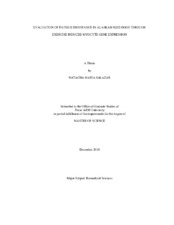Evaluation of Fatigue Resistance in Alaskan Sled Dogs Through Exercise Induced Myocyte Gene Expression
Abstract
The physiological responses to exercise depend on intensity, duration, and type of exercise. The muscles in the body have complex regulation responses in order to create a certain resistance and adaptation to the exercise demands without fatigue. In the following study, we used the model of Alaskan sled dogs in order to analyze changes in gene expression within muscle tissue. Gene expression allows us to look more in depth into temporal or long term biological changes that take place in order for the muscle to adapt and maintain homeostasis. Eight dogs were used for the study; four biopsies from the femoris biceps were taken from each at different time points. Time point 1 (Tp1) untrained dogs, time point 2 (Tp2) after mid training, time point 3 (Tp3) fully trained and time point 4 (Tp4) were taken after dogs had completed a 400 mile run in 4 consecutive days.
Time point one was used as a control ratio for the other three time points for analysis one, for the second analysis Tp1 was eliminated as a control. Analysis, one compared Tp2-Tp3 and Tp3-Tp4; the subsequent analysis looked at Tp1-Tp3. For Mid trained animals compared to fully trained, we looked at a total of 25 differentially expressed genes, for fully trained compared against acute exercise performance, we looked at total of 52 differentially expressed genes (based on a ≤0.01 p-value and fold change of ≥3), and untrained was compared to fully trained where we looked at a total of 26 differentially expressed genes. Known transcriptional regulators were mapped from these differentially expressed genes, such as exocyst complex, lysyl oxidase, protein tyrosine phosphatase, protein kinase C, creatine kinase, HSP40, cytochrome P450, ACSL6 gene responsible for Acyl-CoA synthesis, myosin chain, ATP binding, and ubiquitin, among others. These transcripts were linked to important biological pathways, and functional analysis of these pathways demonstrated that changes found in gene expression are responsible for muscle tissue remodeling, energy storage and metabolism changes, cardiovascular enhancement, and activation of elements that regulate metabolism via the nervous system. The following study of transcriptional regulation mechanisms helped identify specific responses to exercise stimuli in the organism that allow the athletes to adapt to the demands of exercise.
Citation
Salazar, Natacha Maria (2010). Evaluation of Fatigue Resistance in Alaskan Sled Dogs Through Exercise Induced Myocyte Gene Expression. Master's thesis, Texas A&M University. Available electronically from https : / /hdl .handle .net /1969 .1 /ETD -TAMU -2010 -12 -9005.


